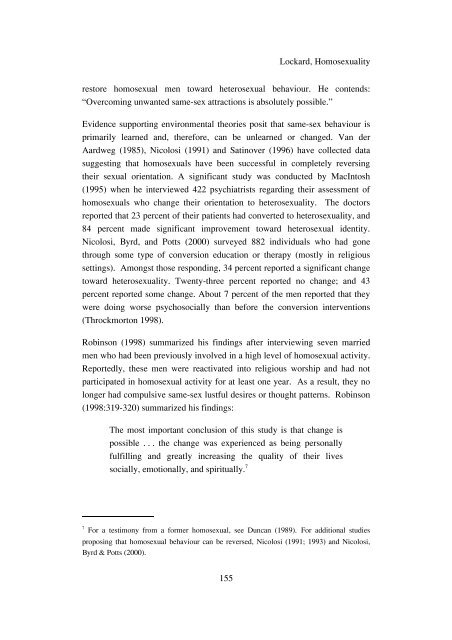Homosexuality: Legally Permissible or Spiritually Misguided?1
Homosexuality: Legally Permissible or Spiritually Misguided?1
Homosexuality: Legally Permissible or Spiritually Misguided?1
- No tags were found...
Create successful ePaper yourself
Turn your PDF publications into a flip-book with our unique Google optimized e-Paper software.
Lockard, <strong>Homosexuality</strong>rest<strong>or</strong>e homosexual men toward heterosexual behaviour. He contends:“Overcoming unwanted same-sex attractions is absolutely possible.”Evidence supp<strong>or</strong>ting environmental the<strong>or</strong>ies posit that same-sex behaviour isprimarily learned and, theref<strong>or</strong>e, can be unlearned <strong>or</strong> changed. Van derAardweg (1985), Nicolosi (1991) and Satinover (1996) have collected datasuggesting that homosexuals have been successful in completely reversingtheir sexual <strong>or</strong>ientation. A significant study was conducted by MacIntosh(1995) when he interviewed 422 psychiatrists regarding their assessment ofhomosexuals who change their <strong>or</strong>ientation to heterosexuality. The doct<strong>or</strong>srep<strong>or</strong>ted that 23 percent of their patients had converted to heterosexuality, and84 percent made significant improvement toward heterosexual identity.Nicolosi, Byrd, and Potts (2000) surveyed 882 individuals who had gonethrough some type of conversion education <strong>or</strong> therapy (mostly in religioussettings). Amongst those responding, 34 percent rep<strong>or</strong>ted a significant changetoward heterosexuality. Twenty-three percent rep<strong>or</strong>ted no change; and 43percent rep<strong>or</strong>ted some change. About 7 percent of the men rep<strong>or</strong>ted that theywere doing w<strong>or</strong>se psychosocially than bef<strong>or</strong>e the conversion interventions(Throckm<strong>or</strong>ton 1998).Robinson (1998) summarized his findings after interviewing seven marriedmen who had been previously involved in a high level of homosexual activity.Rep<strong>or</strong>tedly, these men were reactivated into religious w<strong>or</strong>ship and had notparticipated in homosexual activity f<strong>or</strong> at least one year. As a result, they nolonger had compulsive same-sex lustful desires <strong>or</strong> thought patterns. Robinson(1998:319-320) summarized his findings:The most imp<strong>or</strong>tant conclusion of this study is that change ispossible . . . the change was experienced as being personallyfulfilling and greatly increasing the quality of their livessocially, emotionally, and spiritually. 77 F<strong>or</strong> a testimony from a f<strong>or</strong>mer homosexual, see Duncan (1989). F<strong>or</strong> additional studiesproposing that homosexual behaviour can be reversed, Nicolosi (1991; 1993) and Nicolosi,Byrd & Potts (2000).155
















